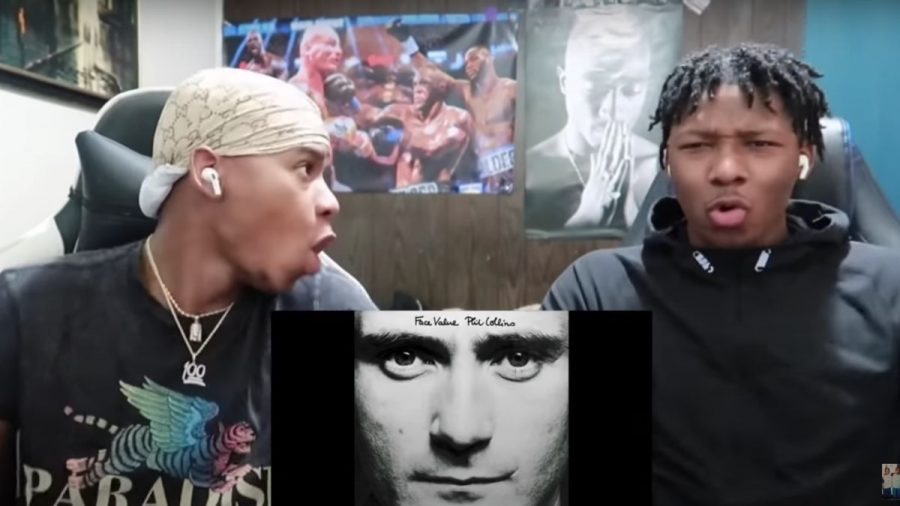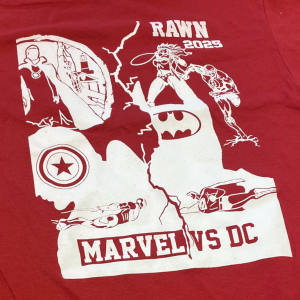Reaction videos: a feeling, experienced
The popularity of reaction videos goes beyond getting some laughs — it’s a million dollar enterprise that is making everyday people famous
The “reaction twins” who made Phil Collins’ “In the Air Tonight” video blow up on social media
May 28, 2021
A reaction video is just that, a video in which people react to something. Reaction videos can be found on multiple hosting services such as Youtube, Twitter and Tik-Tok. Reactions to songs, TV shows, music videos, movies and food are among some reactionary topics. Of late, there are even reaction videos of people reacting to other people’s reaction videos.
In 2011, when reaction videos started emerging more frequently, Sam Anderson of The New York Times Magazine, described them as the following: “The lighting is bad; the camera is almost always unstable; humans are reduced to torsos and elbows and foreheads and bellies; everyone is covered in denim. All of which combines to create a feeling of perfect authenticity: that we are deep inside the engine room of 21st-century America. After watching many, many reaction videos, I started to think of them as the 17th- century Dutch paintings of millennial America.”
Reaction videos today have become more high-tech. Video cameras on phones and computers are in HD, homes have turned into mini-studios and programs such as iMovie have made it possible to create content in real-time. Reaction videos have been passed down to Gen Z, where they are benefiting in multiple ways. As a content producer, Gen Z has found a way to profit from their videos, become famous online influencers, and inadvertently learn from the past.
How did this all start?
Long before YouTube and Tik-Tok, reaction videos were a staple feature of Japanese Variety Shows where celebrities reacted to varied video clips. The transition to online platforms started approximately 15 years ago with a child reacting to a video entitled, “The Scary Maze Game.” The YouTube video featured a boy being filmed on a VHS recorder attempting to navigate a detailed maze within a video game. As the child concentrates on the maze, the game quickly flashes to a photo of Reagan MacNeil from the movie, “The Exorcist,” eliciting an extreme reaction of fear that led the boy to scream, smack the computer screen and begin to cry. The online prank is available for download and has been used over the past generation to scare unsuspecting victims. Saturday Night Live even mimicked the video with it’s own dramatic spoof the same year.
The Money
While many might think that people who produce reaction videos on YouTube have too much time on their hands, money and fame are clearly ulterior motives. According to Clevergirlfinance, “Most YouTubers earn around $18 for every 1,000 advertisement views. That works out to around $3 to $5 per 1,000 video views. Money can be earned from advertisements, sponsorships, merchandise, and affiliate marketing.”
Some of the most successful YouTubers have millions of subscribers and have earned millions of dollars. According to Moneywise, six year old Anastasia Radzinskaya, a Russian-American YouTuber, has over 67 million subscribers and earned over 18.5 million dollars in 2019-2020.
What are RV Students Watching?
Kristine Amaefuna, an RV freshman, enjoys watching reaction videos on YouTube. She is fascinated with singing and voice and gravitates towards reaction videos from YouTuber, Tristan Paredes. Tristan has almost 2.5 million subscribers and is a vocal coach who reviews and reacts to artists who sing live. “I always go to his channel because he gives me more of a professional opinion and I want to learn more about music and get tips,” Amaefuna said.
Violet Bolyard, another RV freshman, says she appreciates reaction videos about movies and songs, but is genuinely entertained by reaction videos surrounding food. “I also watch ones of people eating or trying new foods…reacting to how they taste and stuff,” Bolyard said. “I am a very picky eater, so I have to see how other people see it before I try it.”
What is everyone getting out of this?
With the exception of the possible cash win, people who produce reaction videos are taking advice from their followers on what to react to next. Many support their fan base by listening to their requests and feedback to grow stronger endorsements. Many requests fit the narrative of the subscriber, not the producer, bringing the producer to content that he/she has never witnessed or experienced before. Ultimately, the producer’s reaction is more than just a reaction, it’s a new exposure and possible appreciation of a different genre of music, a video, a TV show, or a unique type of cuisine.
For viewers, it’s sentimental. Viewers can relive moments in the past where music or TV shows provide a euphoria of memories and good vibes. According to TC Gunter, “Watching reaction videos creates nostalgia. You are recreating the setting of your past. This recreation releases the same emotions you felt back then.Your emotional memory has no anchor in time. Your logical mind knows you aren’t time traveling but your emotions overwhelm your logic.”
Not only do viewers and content producers benefit from reaction videos, sometimes the artists behind the actual video can benefit as well. According to the LA Times, when a pair of twins from Gary, Indiana reacted to the song, “In the Air Tonight”, by Phil Collins, their reaction not only went viral, digital sales of the song on iTunes increased 1100%, creating a windfall for Phil Collins.
In the end, everyone is profiting in some way or another, whether it be money, fame, exposure or kindling a wistful affection for the past—they all keep us coming back for more as this has become a fundamental experience of the internet. As Sam Anderson of The New York Times Magazine, claims, “Every image of a human, ever, is of a human reacting to something.”






